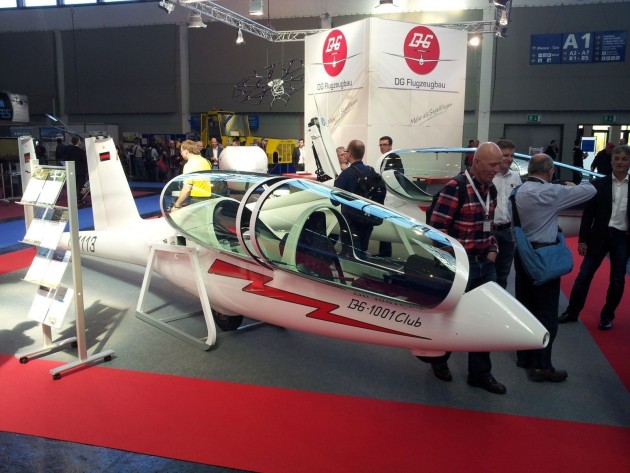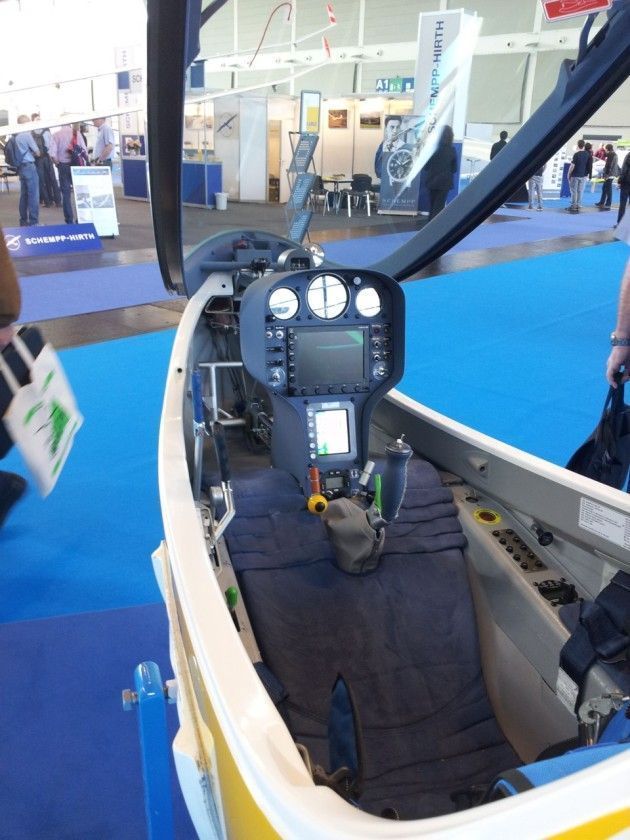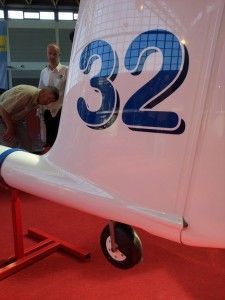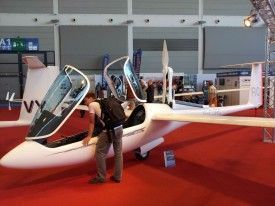The AERO exhibition at Friedrichshafen in Southern Germany takes place every year. Considering costs, the manufacturers of gliders and equipment decided some years ago to take part only every two years. Although it always was not only a chance to see all the news but also to meet friends, it seems that the number of visitors has decreased significantly during the past years. Contributing to this fact is that the air show was abandoned some years ago, and that Southern Germany is quite a long trip for the people from the North – especially since the exhibition ends on Saturday.
So one might ask if it is really worth the effort for manufacturers, especially the smaller ones – but most exhibitors say that being present helps a lot to be better known, business is mainly done afterwards. Still, some of the companies we saw in 2011 stayed away, like Scheibe Aircraft or Clouddancer Covers.
Alexander Schleicher Flugzeugbau presented their latest construction ASG 32 Mi which they had announced just before the beginning of the exhibition. Only the doubleseated fuselage was displayed, the 20-meter-wings will be completed in summer. The maiden flight is expected to be in about a year from now. The fuselage was taken from the ASH 30 until about 60 cm in front of the tail which is a new design. Special attention was given to the design of the elevator which comes in a double-trapezoid shape with the tips slightly bent downwards. The fin has been designed to pick-up the retractable tailwheel. It is connected to the mail wheel but due to a spring construction there is no additional force required to retract both wheels at the same time.
“Of course, the ASG 32 is a reaction to the success of the Arcus”, says Joschka Schmeisl who is responsible for the construction together with Michael Greiner who did the design. The two-seater will be available as glider, self-lauching with the popular 41kW Austro engine and with an electric sustainer. This sustainer however still has to be developed but is supposed to have a similar performance compared to a regular SOLO-sustainer.
Among ASH 31 Mi and ASG 29 E there was also an ASH 30 Mi on display. The prototype was already presented in 2011, now serial number four has been completed. Joschka Schmiesl explains why the “30”-project has experienced delay: “As the fuselage was a completely new design, we had to accomplish the complete certification program including a cockpit crash test which failed at the first attempt. So we had to do some modifications. It was our primary goal to finish the whole certification process before producing large numbers. So it is just a rumor that the ASH 30 lacks performance – we just did not have enough gliders to prove it.”
Bernd Weber of Schempp-Hirth Flugzeugbau is not afraid of the new competitor in the 20-Meter two-seater class. “The performance and handling of our Arcus makes us very self-confident. Pilots like it from the first minute.” Maybe that explains why you have to wait three years from your order until the delivery of a new aircraft – although Weber sometimes does not understand why clubs order an Arcus whereas a Duo Discus would match their needs much better.
Schempp-Hirth displayed the Arcus M, the Quintus M and the fuselage of a Ventus 2cxT. “We are currently an a phase of consolidation and trying to finish the certification of the Quintus”, says Bernd Weber. There is no new glider to be expected in the near future.
Two other manufacturers are also trying to play the game of two-seaters: Albastar from Slovenia showed up with the incomplete fuselage of the AS-18m GEN. It has been developed from the AS-18 M, a self-launching ultralight glider which was already shown in 2011, but only two of them are flying until now. AS-18m GEN comes with a 42 kW electric engine (FES) in the nose which is driven by a conventional 65 hp engine in the center fuselage via a generator. Alternatively, the engine can be substituted by batteries.
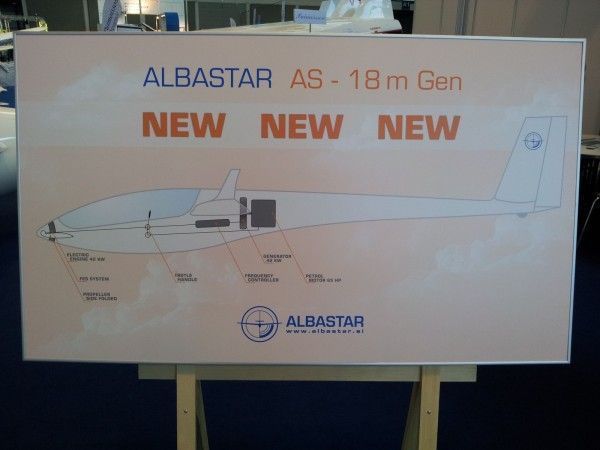
Albastar from Slowenia offers their AS-18m (twoseater) with an engine inside the fuselage which drives a FES in the nose. It will be self-launchable!
Being asked about a new HpH-doubleseater in the past, HpH-boss Jaroslav Potmesil always answered: “It will come in April. But I don’t know yet in which year.” This year however, HpH finally announced the development of the Twin Shark, a 20-meter flapped glider which is supposed to take-off at the end of this year. At a MTOW of 800 kg, a wing loading of up to 52 kg/m² can be expected according to company publications. The first Twin Shark will be self launching, using a Binder Solo 2625-02 with 65 hp. Later, we may also expect a jet sustainer which is planned to deliver a similar performance as the single-seated Shark JS with jet sustainer.
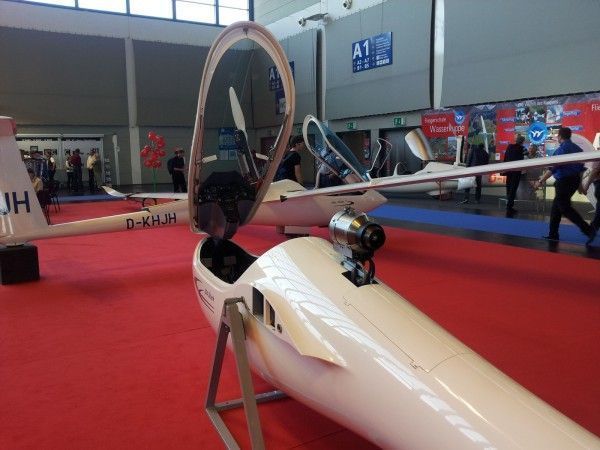
HpH from the Czech Republic republic displays their 304 Shark as selflaucher and jet sustainer. They announced that their newest project 304 Twin Shark (selflaunching twoseater) will probably be ready for its maiden flight by the end of the year.
Surely, some visitors had expected to see the Antares 23 at Lange Aviations booth and to compare it to its sister ship Quintus, but the only aircraft currently available, the first “real” 23T, will be delivered to its customer these days. So Lange only showed up with an Antares 20E, frequently demonstrating how easy it is to start the electric engine in less than 20 seconds. In addition, the Antares 18T could be seen which is equipped with a conventional sustainer.
This engine can also be retrofitted in older Antares 18. “We decided to develop our own sustainer because it weighs 30 to 40 kg less than its electric equivalent”, explains sales manager Dirk Rabenau. So they did not change their philosophy because of “dangerous” lithium batteries? “No, because an incident like in the Boeing 787 can not happen with our battery packs. They have a different chemical composition and are monitored by a lot of safety mechanisms.”
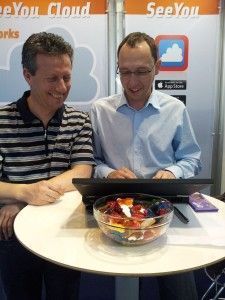
IGC-delegate Christof Geissler (left) and Andrej Kolar (Naviter) discuss possiblities to create videos from SeeYou’s 3D-animation to show them during competition briefings…
There is also news from the software providers: Naviter’s SeeYou now offers a search function “Find my flight” which allows to define specific filter criteria such as distance, duration or region to find a flight. They also presented Oudie 3 for Paragliders, providing a battery duration of 15 hours and an internal variometer. Still to come: Uploading flights from SeeYou Cloud directly to OLC – a problem which might take a little longer, but is said to be not a technical issue…
Butterfly Avionics recently added this upload feature, so flights from the iPhone can go directly to OLC. In addition, they showed the prototype of Butterfly Nav Pro, a 5.7”-display which combines navigation and traffic data and can easily be mounted onto the panel using a regular 57mm cut-out.
Those looking for a cheaper method to navigate could try the features of XCSoar which is an open-source project for Windows Mobile and Android devices. Also shown was the Skylines Project, a true alternative to OLC for uploading and evaluating flights including live tracking. XCSoar is supported by StrepPla which has annonced to cease the development of PocketStrePla and recommends XCsoar or its “cousin” LK8000.
As a conclusion of spending just one day at AERO, it seems that less people are willing to make the journey to Friedrichshafen without a defined goal. A lot of glider pilots left the premises with bags, so it maybe is an opportunity to make a good deal and save shipping costs. Also, if you always wanted to just sit in a Quintus, that’s probably the easiest way. But if you want to spend a lot of money on a glider, it is probably better to make an appointment outside AERO – all company representatives are usually busy during the fair as everybody stops by to say hello; which in contrast makes AERO a perfect place to meet old friends that you only see once in a while.
All Photos by Helge Zembold

























